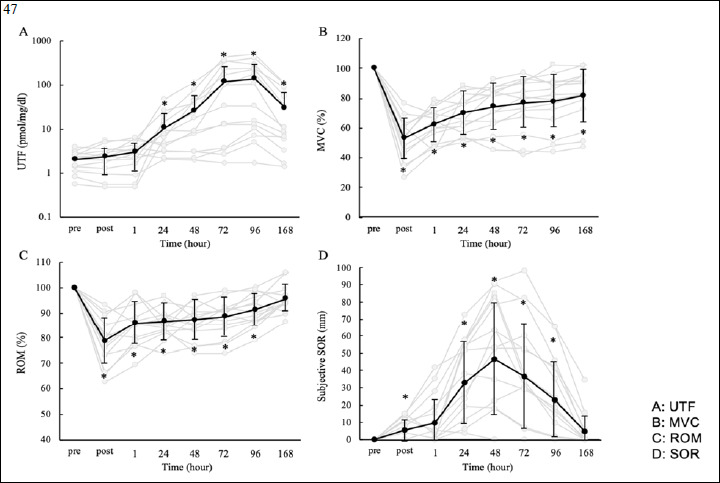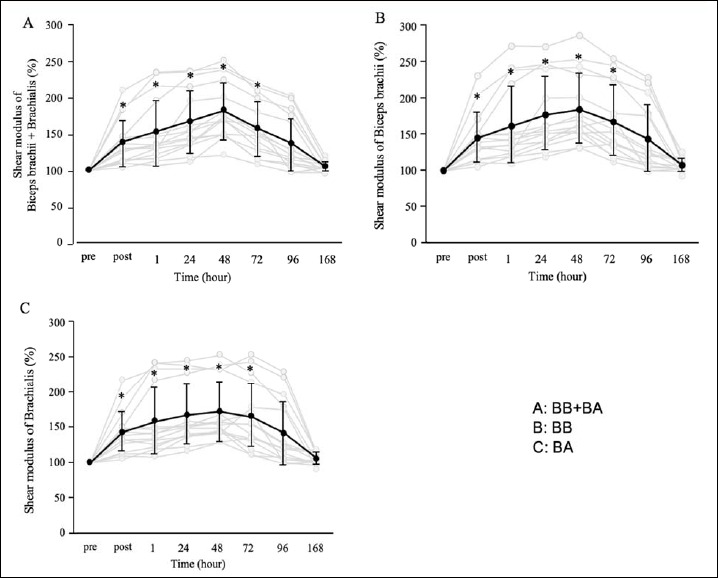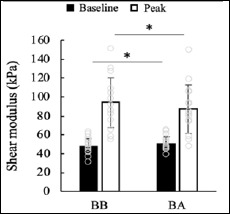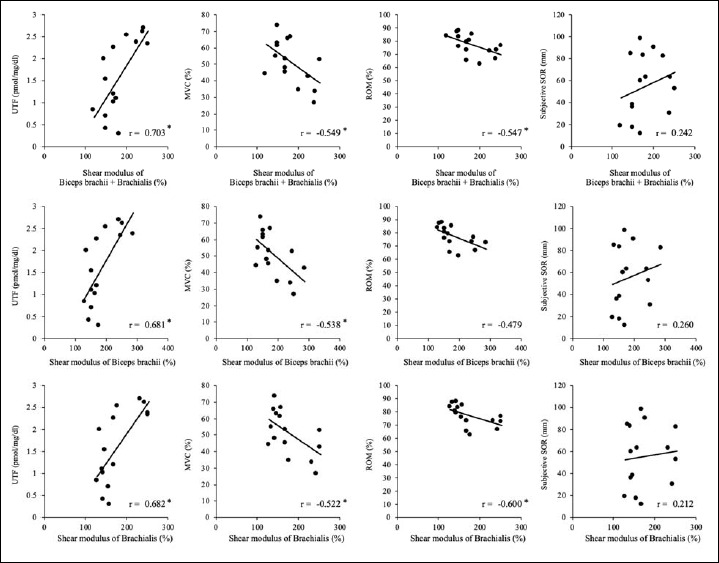Abstract
The study aimed to investigate the relationships between the shear modulus of the biceps brachii (BB) and brachialis muscle (BA) and the total of the two (BB+BA), and urinary titin N-terminal fragment (UTF), maximum voluntary isometric contraction (MVC), and other indirect markers. Fifteen healthy men performed five sets of 10 eccentric contractions using a dumbbell corresponding to 50% of MVC at 90° measured at baseline. The elbow joint of the left arm was extended from 90° to 180° (180° = full extension) in 5 s in the exercise, and was returned with support from the examiner to prevent concentric contraction. Shear modulus of BB and BA were measured by ultrasound shear wave elastography, and UTF, MVC, and range of motion of the elbow joint (ROM) were recorded before; immediately after; and 1, 24, 48, 72, 96, and 168 h after the exercise. After calculating the shear modulus of BB and BA, two values were added (BB+BA). The shear modulus peaked at 48 h, UTF peaked at 96 h, MVC and ROM changed largest at immediately, and muscle soreness peaked at 48 h post-exercise. Significant (p < 0.05) relationships were found between changes in BB shear modulus and BA shear modulus (r = 0.874), BB+BA shear modulus (r = 0.977), UTF (r = 0.681), and MVC (r = −0.538). Significant (p < 0.05) relationships were also observed between changes in BA shear modulus and BB+BA shear modulus (r = 0.957), UTF (r = 0.682), MVC (r = −0.522), and ROM (r = −0.600). Moreover, significant (p < 0.05) relationships were observed between changes in BB+BA shear modulus and UTF (r = 0.703), MVC (r = −0.549), and ROM (r = −0.547). These results indicate that shear modulus of each muscle (i.e., BB and BA) provide more precise information about muscle damage than UTF, MVC and ROM.
Key points.
Moderate relationships exist between changes in shear modulus and other muscle damage markers such as UTF, MVC, and ROM.
No significant difference was found for the changes in shear modulus between biceps brachii and brachialis muscle.
To better understand the relationships between the shear modulus of the elbow flexors and UTF and MVC, assessing the brachioradialis shear modulus is necessary.
Key words: Shear wave elastography, exercise-induced muscle damage, biceps brachii, brachialis muscle
Introduction
Skeletal muscle damage induced by eccentric muscle contraction (exercise-induced muscle damage: EIMD) has been indicated by several indirect markers such as a decrease in maximum voluntary contraction (MVC) force and range of motion (ROM) and increases in creatine kinase (CK), muscle stiffness, delayed-onset muscle soreness (SOR), and swelling (Murayama et al., 2000; Chen et al., 2007; Damas et al., 2016; Inami et al., 2022). In addition, increases in the urinary titin N-terminal fragment (UTF) were reported after eccentric exercise (Kanda et al., 2017) and a significant relationship between changes in UTF and MVC (r = −0.596) and CK (r = 0.966) was reported (Yamaguchi et al., 2020c). UTF has recently been used as an alternative plasma biomarker that reflects the magnitude of global EIMD.
Although a prolonged decrease in MVC is considered a good non-invasive marker of muscle damage (Damas et al., 2016), accurate quantification of individual muscle damage requires histological examination of muscle biopsy samples from individual muscles by determining the number of myofibrillar disruptions (Raastad et al., 2010). However, as this is an invasive procedure, previous studies focusing on differences in individual muscle damage to the biceps brachii (BB) and brachialis muscle (BA) that are synergistic to elbow flexion, have used imaging techniques such as magnetic resonance (MR) and/or ultrasound. For example, Nosaka et al. (2001) evaluated elbow flexors (i.e., BB and BA) that performed eccentric exercise by means of MR T2-weighted images. They found that the arm curl eccentric exercise in the longer muscle length condition (100° to 180°; full extension 180°; same below) induced greater damage to the BB and BA than the arm curl eccentric exercise in the short muscle length condition (50° to 130°). On the other hand, a decrease in MVC is related to the number of disrupted fibers (Raastad et al., 2010), and there have been increasing reports that muscle shear modulus assessed by ultrasonic shear wave elastography (SWE) is used to assess muscle damage (Lacourpaille et al., 2014; 2017; Inami et al., 2022; Ličen and Kozinc, 2022). For example, Lacourpaille et al. (2014) compared differences in BB and BA that performed eccentric exercise between 60° to 175° of the elbow joint using MR (T2 relaxation time) and SWE. They found no difference in changes in shear modulus between the synergistic muscles (i.e., BB and BA), which was also shown by the MR results. Subsequently, Lacourpaille et al. (2017) used only SWE and found that the index of shear modulus increased in BB greater than in BA for high load, while no significant difference was found between these muscles for low load. These studies suggest that the magnitude of individual muscle damage differs based on the involvement of muscle fiber length and high load.
To our knowledge, only one study (Inami et al., 2022) has investigated the relationships between changes in muscle shear modulus and UTF, MVC, other indirect markers after eccentric exercise. Our previous study showed that the correlation coefficient between MVC and shear modulus was −0.716 and that between UTF and BB shear modulus was 0.686 after eccentric exercise of the elbow flexor. Titin, measured by UTF, is a sarcomere constituent protein that mainly supports the contraction of actin and myosin filaments in the fiber direction (longitudinal direction). Muscle shear modulus is also defined as a measure along the sarcomere/muscle fiber direction (longitudinal direction), similar to UTF (Inami & Kawakami, 2016). This suggests that although global indirect markers of muscle damage such as titin and muscle strength are involved in changes in muscle stiffness after eccentric exercise, only the shear modulus of BB has been evaluated not BA (Inami et al., 2022). UTF has a stronger relationship with MVC (r = −0.83) than with the BB shear modulus (r = 0.686); however, in a previous study (Damas et al., 2016) that analysed the role of indirect markers, including MVC after eccentric exercise of the elbow flexors, shear modulus and UTF were not included as indirect markers. Therefore, the relationships between changes in the synergistic muscle shear modulus of the elbow flexors (i.e., BB+BA and changes in UTF and MVC after elbow flexor eccentric exercise are not known.
Therefore, the present study further investigated the relationships between the BB and BA shear modulus and UTF, MVC, and other indirect markers. It was hypothesized that the relationships would be stronger when both BB and BA were included for the shear wave analyses than BB alone.
Methods
Participants
Fifteen healthy male participants (age, 22.0 ± 4.7 years; height, 1.7 ± 0.04 m; and body mass, 61.6 ± 4.7 kg) participated in this study. The sample size was estimated based on our previous study (Inami et al., 2022) using G*Power software (G*Power 3.1.9.2; Heinrich-Heine-Universität Düsseldorf, Düsseldorf, Germany) with an effect size of 0.68, α level of 0.05, and power (1-β) of 0.80 for a possible correlation between UTF and shear modulus, showing that 11 participants were necessary.
A month before and during the experiment, the participants were requested to avoid strenuous or unfamiliar exercise, maintain normal dietary and sleeping habits, and avoid consuming anti-inflammatory drugs (such as non-steroidal anti-inflammatory drugs) or dietary supplements (such as vitamins, proteins, and amino acids).
They were informed of the nature, aims, and risks associated with the experimental procedures before providing written informed consent. The study was conducted in accordance with the principles of the Declaration of Helsinki and approved by the university’s ethics committee (21-003).
Experimental design
The study was conducted over nine days based on our previous study (Inami et al., 2022). Before the experiment, the participants were familiarized with the muscle strength measurement method. On the first day before the eccentric exercise, a measurement session (pre) was conducted, and eccentric exercises were performed on the elbow flexor muscles. After the eccentric exercise, the same measurement sessions were repeated immediately after (post), and 1, 24, 48, 72, 96, and 168 h post-exercise. During the measurement session, MVC, ROM, and SOR were measured in addition to BB and BA shear modulus and UTF.
Eccentric exercise
Participants were seated on an arm-curl bench with the hip flexed at 85° (0° = full hip extension). As described in a previous study (Nosaka & Newton, 2002), the participants were tightly secured to an arm-curl bench with non-elastic straps during the exercise. They completed five sets of 10 eccentric contractions with a dumbbell weighing 50% of the elbow joint MVC of the left arm measured during the pre session. The elbow joint was extended from 90° to 180° (180° = full extension), in 5 s. To ensure that only eccentric contractions were performed, the examiner supported the participant’s elbow flexion during the concentric phase. All contractions were repeated every 3 s, and a recovery period of 2 min was provided between sets. Muscle activity was monitored using an electromyogram (EMG; DataLITE EMG, Biometrics Ltd., UK) attached to the skin over the BB. The sampling frequency was set to 1000 Hz, and an offline digital filter was applied with a bandpass filter of 10-450 Hz. Surface EMG signals of BB were recorded during the eccentric exercise.
Muscle strength (elbow MVC)
Maximum isometric elbow flexion strength was evaluated during 5 s of isometric MVC at an elbow angle of 90° using a handheld dynamometer (Mobie, SAKAI Medical Co., Ltd. Japan). Two trials were performed, and the trial with the highest isometric strength (MVC) was used for further analysis. If the difference between the two measurements exceeded 10%, a third measurement was performed.
Range of motion (ROM)
A semi-permanent ink marker was used to mark the center of the acromion, lateral epicondyle, and ulnar styloid. The elbow joint angle was photographed in relaxed and flexed states to determine the active ROM, and the angle formed between the line connecting the center of the acromion and the lateral epicondyle and that connecting the lateral epicondyle and the ulnar styloid was calculated using ImageJ software (version 1.39, NIH, USA). After the relaxed and flexed angles were determined, the re-relaxed angle was subtracted from the flexed angle to determine the elbow joint ROM (Yamaguchi et al., 2020b).
Subjective muscle soreness (SOR)
We measured SOR as a subjective evaluation of muscle damage (Inami et al., 2022). SOR was assessed using a 100-mm visual analogue scale (VAS), with 0 indicating no pain and 100 representing extreme pain. SOR was measured when participants actively extended their arms. Participants were instructed to hold their shoulder joints at 90° flexion and elbow joints at 180° active extension and to mark their perceived SOR levels on the VAS.
Shear modulus of BB and BA
BB and BA shear modulus measurements were performed at 180° elbow joint (full extension), 10° shoulder joint extension, and 30° shoulder joint abduction while lying supine on a bed. The ultrasonographic apparatus used an ultrasound shear wave scanner in “shear wave” mode coupled with a linear array transducer (Aplio 300, Canon Co., Ltd., Japan). Based on previous studies (Nosaka and Clarkson, 1996; Hodges et al., 2003; Inami et al., 2022), the ultrasound transducer was placed over the muscle belly of the long head of the BB and BA (that is, the location of the probe was approximately 50% [BB] and 70% [BA] of the upper arm length from the acromial process of the scapula to the lateral epicondyle of the humerus). Using a semi-permanent ink marker, the probe was attached to the same location across sessions and days, and the measurement marks were maintained during the experimental period. Throughout the scanning, care was taken not to press or deform the muscles. The elastographic images were acquired after ensuring that the color map and propagation imaging of the shear wave speed were stable for a few seconds during the session. The elastographic images obtained were transferred to a computer as bitmaps (.bmp) files, calculated, averaged using a dedicated software (iElastographic image analyser, Takei Scientific Instruments Co., Ltd., Japan), and used for analyses. The mean shear modulus of each muscle was calculated over the region of interest from which the aponeurosis and subcutaneous adipose tissues were excluded from the B-mode images. In the preliminary experiment conducted before the research, the shear modulus of BB and BA in the resting muscle condition of the three images had a coefficient of variation of 1.6 ± 1.1% and 1.7 ± 1.1%, respectively. Thus, the average value of the three images was used as the representative value of the shear modulus of each muscle. With reference to the calculation method of a previous study (Murayama et al., 2020), after calculating the shear modulus for each BB and BA, BB+BA was further calculated by adding them. When it was uncomfortable to completely extend the elbows owing to pain, the elbow joint was slowly extended (1° s-1) and completely extended gradually while consulting the participant so that the stretch reflex does not occur (Howell et al., 1985; Murayama et al., 2000; Inami et al., 2022). All measurements and analyses of the ultrasonography data were performed by an experienced examiner (>10 years of experience).
Titin N-terminal fragment excretion assays
Approximately 3 mL of urine was collected from each participant to measure the UTF concentrations via an enzyme-linked immunosorbent assay (ELISA) system using a titin N-terminal fragment assay kit (Immuno-Biological Laboratories Co., Ltd., Japan), as previously described (Yamaguchi et al., 2020a). The samples were stored at −20 °C for later analyses. Thawed urine samples were diluted at 1:5-1:500 such that the diluted samples were within the linear detection range. Diluted samples and standard solutions were added to each antibody-coated well of a 96-well microplate and incubated at 37 °C for 60 min. Subsequently, the microplates were washed four times with wash buffer, labeled antibodies were added to each well, and the plates were incubated again at 37 °C for 30 min. The tetramethylbenzidine solution was incubated at room temperature for 30 min after washing with the wash buffer five times. Stop solutions were added to each well during the final step of the ELISA. Absorbance was measured using a microplate reader at a wavelength of 450 nm and subwavelength of 650 nm (Thermo Fisher Scientific, Multiskan FC, USA). The UTF concentration was calculated using a linear regression model, and urinary creatinine levels were estimated using an automated analyser (Bio Majesty JCA-BM8060, JEOL, Japan). The UTF values were normalized relative to urinary creatinine (Cr) (each raw data point in the urine/Cr concentration) (Maruyama et al., 2016). Normal UTF concentrations ranges between 0.9-7.6 pmol/mg/dL (Yamaguchi et al., 2020b).
Statistical analysis
Values are mainly expressed as mean ± standard deviation. Changes after exercise were compared between each condition using a two-way analysis of variance (ANOVA) with two factors (muscle × time). If a significant interaction effect was found, a post hoc test was performed to identify the time points of significant differences between conditions using Bonferroni’s method. This test indicated a non-normal distribution of the UTF data; therefore, a logarithmic transformation (log10) was applied before the analysis (Inami et al., 2022). Pearson's correlation analysis was used to correlate the BB+BA, including the BB and BA shear modulus, with the other measures. Statistical significance was set at p < 0.05. All statistical analyses were performed using IBM SPSS Statistics 28 software (SPSS Inc., Chicago, IL, USA).
Results
Table 1 presents the baseline values of all criteria for measurement. Figures 1 and 2 summarize the changes in each muscle damage marker over time. UTF increased significantly from 2.1 ± 1.0 to 137.9 ± 168.3 pmol/mg/dL 96 h after exercise and remained significantly higher than at baseline until 168 h after exercise (Figure 1A). MVC decreased significantly from a baseline value of 17.9 ± 2.3 to 9.7 ± 3.5 kgf (51.2 % from baseline) immediately after exercise and remained significantly lower than at baseline until 168 h after exercise (Figure 1B). ROM significantly decreased from 163.3 ± 5.4° to 156.3 ± 8.1° (78.9 % from baseline) immediately after exercise and remained significantly lower than at baseline until 96 h after exercise (Figure 1C). Subjective SOR on elbow extension was significantly higher immediately after and 24-96 h after exercise than at baseline (Figure 1D).
Table 1.
Baseline values of all measurement criteria.
| BB+BA | 98.4 ± 15.6 (73.3-126.0) kPa |
| BB | 47.9 ± 8.5 (29.8-62.2) kPa |
| BA | 50.6 ± 7.6 (37.6-63.8) kPa |
| UTF | 2.1 ± 1.0 (0.6-3.9) pmol/mg/dL |
| MVC | 17.9 ± 2.3 (13.5-21.7) kgf |
| ROM | 163.3 ± 5.4 (154.3-171.9) degree |
| SOR | 0.0 ± 0.0 (0.0-0.0) mm |
BB+BA: shear modulus of biceps brachii + brachialis, BB: shear modulus of biceps brachii, BA: shear modulus of brachialis, UTF: urinary titin N-terminal fragment, MVC: maximum voluntary contraction, ROM: range of motion, and SOR: subjective muscle soreness.
Figure 1.

Changes in [A] urinary titin N-terminal fragment (UTF), [B] maximum voluntary contraction (MVC), [C] range of motion (ROM), and [D] subjective muscle soreness (SOR). The values for each time course significantly differed from those before the first session (pre). *p < 0.05.
Figure 2.

Comparison between the change in muscle shear modulus of the [A] biceps brachii + brachialis (BB+BA), [B] biceps brachii (BB), and [C] brachialis (BA) (normalized change from baseline [%]). *p < 0.05.
BB+BA shear modulus significantly increased from an initial value of 98.4 ± 15.6 to 181.0 ± 51.5 kPa (182.8 % from baseline) 48 h after exercise and decreased until recovery at 96 h after exercise (Figure 2A). BB shear modulus significantly increased from an initial value of 47.9 ± 8.5 to 94.1 ± 26.4 kPa (196.4 % from baseline) 48 h after exercise and decreased until recovery at 96 h after exercise (Figure 2B). BA shear modulus significantly increased from an initial value of 50.6 ± 7.6 to 86.9 ± 25.4 (171.7 % from baseline) 48 h after exercise and decreased until recovery at 96 h after exercise (Figure 2C). Figure 3 shows the baseline and peak shear modulus in BB and BA. The baseline shear modulus was significantly higher for BA than BB (p = 0.03), and the peak was significantly higher for BB than BA (p < 0.001). Figure 4 shows the distribution of elbow flexor shear modulus and other muscle damage indices.
Figure 3.

Difference in the baseline and peak muscle shear modulus of the biceps brachii (BB) and brachialis (BA) muscles. *p < 0.05.
Figure 4.

Correlation coefficients between damage markers. The top shows the relationship between the shear modulus of biceps brachii + brachialis (BB+BA), and other muscle damage indices; the middle shows the relationship between the shear modulus of the biceps brachii (BB) and other muscle damage indices; the bottom shows the relationship between the shear modulus of the brachialis (BA) and other muscle damage indices. * p < 0.05.
Regarding the correlation coefficients with shear modulus and other measures, BB shear modulus showed significant positive correlations with BA (r = 0.874) as well as BB+BA shear modulus (r = 0.977) and UTF (r = 0.681), whereas a negative correlation was observed for MVC (r = −0.538). BA shear modulus showed significant positive correlations with BB+BA shear modulus (r = 0.957) and UTF (r = 0.682), but a negative correlation with MVC (r = −0.522) and ROM (r = −0.600). BB+BA shear modulus showed significant positive correlations with UTF (r = 0.703), and a negative correlation with MVC (r = −0.549) and ROM (r = −0.547).
Discussion
The results showed that (1) the correlation values between BB+BA shear modulus and UTF or MVC were slightly higher than with those with BB shear modulus alone; (2) there was no difference in changes in shear modulus between BB and BA. These findings support our hypothesis.
According to a previous study (Damas et al., 2016), the degree of EIMD associated with eccentric exercise strongly depends on the extent of MVC change. In this study, MVC decreased by 51.2% immediately after the exercise. A decrease greater than 50%, which is considered severe (Paulsen et al., 2012), was similarly reported in previous studies that used dumbbell exercises to induce muscle damage (Chen et al., 2007; Lavender and Nosaka, 2006), including ou r previous study (Inami et al., 2022). Additionally, the shear modulus peak value of BB was approximately twice (1.96-fold) as large as that of the resting muscle shear modulus (47.9-94.1 kPa), and the correlation between BB shear modulus and titin measured by UTF was 0.68. These results are consistent with those of a previous study (Inami et al., 2022) that measured BB shear modulus using similar methods (changes of 1.98-fold and correlation coefficient of 0.7). Furthermore, similar results were obtained regarding time-course change, in which BB shear modulus peaked after 48 h, and the titin measured by UTF peaked after 96 h. These results suggest that the exercise tasks and/or measurement methods used in our study are appropriate.
The correlation values between BB+BA shear modulus and UTF or MVC were slightly higher than those with BB alone. Larger damage to the BB, a biarticular muscle, has also been reported in MR T2 changes (Kulig et al., 2001) besides that in studies with SWE (Lacourpaille et al., 2014; 2017), and is also explained from the perspective of the superiority of damage to fast-twitch and type-II fibers (Chapman et al., 2013). In contrast to the results of these studies, BA shear modulus increased in similar magnitudes to that of BB shear modulus, and changed over a similar time-course. Consequently, it did not differ between muscles in our study. Regarding the eccentric exercise in this study, each muscle shear modulus was measured at 180° (full extension) of the elbow joint, and the increase in BA shear modulus may have been large compared with that in previous studies using SWE (Lacourpaille et al., 2014; 2017). Considering that BA reportedly contributes the most to the torque among the elbow flexors (Kawakami et al., 1994), the shear modulus values of the BB and BA with full extension of the joints affected by the damaged muscles were large, which may be reasonable. In other words, the results showed that the increased BB+BA shear modulus after eccentric exercise was maximized. However, the relationship between BB+BA and UTF or MVC, which was considered maximized, was slightly greater than that for BB shear modulus alone. The detailed physiological and/or morphological relationship between the shear modulus and other indirect muscle damage markers remains unknown. As one of the major reasons, it was considered that shear modulus in this study did not contribute entirely to elbow flexor muscles, with only approximately 87% (BB+BA) of the physiological cross-sectional area considered (Kawakami et al., 1994). The brachioradialis muscle, which could not be measured in this study, contributes 19% to the elbow flexor torque (Kawakami et al., 1994); this limitation of our study could explain the moderate relationship between shear modulus and global indirect damage markers. As mentioned in the review by Ličen & Kozinc (2022) on using SWE to assess muscle damage, the findings about the relationship between SWE and other indirect markers (particularly UTF) is lacking compared to that on other indirect markers such as MVC. Although the findings of this study contributed to this knowledge, additional studies are needed to investigate how well the shear modulus reflects the global extent of muscle damage. However, since an important point of our results is that changes in the sarcomere structure shortened by damage are related to changes in shear modulus, we considered it more relevant to include information about synergistic muscles contributing to joint motion when investigating the relationship between global markers and local markers. SWE can provide feedback immediately after measurement, which is advantageous considering that UTF analysis using urine samples currently takes multiple days.
From the perspective of time-course change of each indirect muscle damage marker, BB and BA shear modulus peaked at 48 h, UTF peaked at 96 h, MVC and ROM peaked at post, and SOR peaked at 48 h post-exercise. These patterns of time-course changes, amount of change, and range of values support previous results (Yamaguchi et al., 2020c; Inami et al., 2022). In this study, UTF and MVC showed the highest correlation among all five indirect markers measured (r=−0.776). Intense eccentric contractions contract individual muscle fibers longitudinally, resulting in the destruction of muscle cell membranes and myofibrils (Yu et al., 2003). This destruction is observed immediately after exercise, and several hours later, myofibrils are further degraded by proteases (Yu et al., 2003). The physiological mechanism responsible for why BB+BA shear modulus peaked at 48 h post-exercise remains unclear. However, this may be related to the damage to components of the excitation-contraction (E-C) coupling process and/or to the time course in which the unstable sarcomere shortens and stabilizes, including the cross-bridge number and titin (Proske & Morgan 2001). Moreover, calpain 3, a protease, is expressed primarily in skeletal muscle and is associated with titin (Ono et al., 2016). Calpain 3 specifically cleaves and degrades titin, and this phenomenon has been confirmed to induce muscle damage after eccentric contraction (Raastad et al., 2010). Therefore, it is logical that UTF peaks after BB+BA peaks at 48 h, and the delayed peak of UTF mentioned above is considered to be strongly influenced by this degrading enzyme (calpain). The presence of titin, a metabolite excreted via mechanical stimulation and locally generated intramuscularly by eccentric exercise, may be explained by the time difference until it could be excreted into the urine via the lymph and blood vessels. Although detailed information is unavailable on the relationship between MVC and UTF, which are considered good indirect markers, and UTF, which captures the same longitudinal direction of muscle contraction as MVC, is valuable as a global indirect marker specific to eccentric contraction. However, considering that UTF still peaks at 96 h, MVC is beneficial in terms of early prediction of the extent of damage and cost-effectiveness.
We also found an interesting relationship between BA shear modulus and ROM. Although active ROM was measured in this study, our results suggest that BA, not BB, may be involved in limiting ROM. Our previous study showed no significant relationship between BB and ROM (Inami et al., 2022). Moreover, we observed that elbow flexors are not arranged at the same relative length, and the difference in muscle fiber length between BB and BA contributes to this phenomenon. In addition, the site close to the moving joints (elbow joint) may also be severely damaged (Inami et al., 2019). SOR was not correlated with other markers, including shear modulus, UTF, and MVC. Although pain due to EIMD may be associated with reduced maximum voluntary contraction torque to an extent (Salomoni et al., 2016), SOR of the quadriceps muscles after eccentric exercise was not correlated with the shear modulus changes (Chalchat et al., 2022; Xu et al., 2019). It may not have acted as a confounding factor in our experiment.
In this study, we mainly included BA and analysed the relationship between indirect markers such as UTF and MVC. However, it may be necessary to include factors in the brachioradialis muscle to better understand the relationship between shear modulus and UTF and MVC, as discussed. In addition, all urine samples were collected in the same time zone; however, the data were not pooled, and the diurnal variation of UTF was unclear. This issue may have also affected the correlation between UTF and other markers. Moreover, the shear modulus of all the muscles of the upper arm and forearm that contribute to elbow flexion were accumulated, and detailed examination with other indirect markers would require multiple regression or cluster analysis.
Conclusion
The present study found that BB+BA shear modulus had a slightly stronger relationship with UTF or MVC than BB alone. When investigating the relationship between global markers, such as UTF and MVC, and local markers, such as shear modulus, it is more relevant to include more information about synergistic muscles contributing to joint motion.
Acknowledgements
Taisho Pharmaceutical Co., Ltd. funded and collaborated with this study; however, the company did not influence the scientific interpretation of the collected data or publication of this article. The authors declare that this study complies with the laws and regulations of the host countries. The datasets generated and analysed during the current study are not publicly available but are available from the corresponding author, who was an organizer of the study.
Biographies

Takayuki INAMI
Employment
Institute of Physical Education, Keio University, Japan
Degree
Ph.D.
Research interests
Muscle Biomechanics, Sports Medicine
E-mail: inamit@keio.jp

Shota YAMAGUCHI
Employment
Institute of Physical Education, Keio University, Japan
Degree
Ph.D.
Research interests
Exercise-induced muscle damage
E-mail: yamaguchi.s@keio.jp

Takuya NISHIOKA
Employment
Institute of Physical Education, Keio University, Japan
Degree
Ph.D.
Research interests
Strength and conditioning
E-mail: nishioka.t@keio.jp

Hiroyuki ISHIDA
Employment
Sports Medicine Research Center, Keio University, Japan
Degree
M.D., Ph.D.
Research interests
Sports medicine
E-mail: RXB03102@nifty.ne.jp

Akihisa MORITO
Employment
R&D Laboratories, Self-Medication, Taisho Pharmaceutical Co., Ltd.
Degree
Ph.D.
Research interests
Sports Science and Nutrition
E-mail: a-morito@taisho.co.jp

Satoshi YAMADA
Employment
R&D Laboratories, Self-Medication, Taisho Pharmaceutical Co., Ltd.
Degree
MSc
Research interests
Sports Science and Nutrition
E-mail: sat-yamada@taisho.co.jp

Naoya NAGATA
Employment
Institute of Physical Education, Keio University, Japan
Degree
M.P.Ed
Research interests
Sports psychology, Attention, Basketball
E-mail: nnagata@keio.jp

Mitsuyoshi MURAYAMA
Employment
Institute of Physical Education, Keio University, Japan
Degree
Ph.D.
Research interests
Muscle hardness, eccentric exercise
E-mail: murayama@z3.keio.jp
References
- Chalchat E., Siracusa J., Bourrilhon C., Charlot K., Martin V., Garcia-Vicencio S. (2022) Muscle shear elastic modulus provides an indication of the protection conferred by the repeated bout effect. Frontiers in Physiology 13, 877485. https://doi.org/10.3389/fphys.2022.877485 10.3389/fphys.2022.877485 [DOI] [PMC free article] [PubMed] [Google Scholar]
- Chapman D.W., Simpson J.A., Iscoe S., Robins T., Nosaka K. (2013) Changes in serum fast and slow skeletal troponin I concentration following maximal eccentric contractions. Journal of Science and Medicine in Sport 16, 82-85. https://doi.org/10.1016/j.jsams.2012.05.006 10.1016/j.jsams.2012.05.006 [DOI] [PubMed] [Google Scholar]
- Chen T.C., Nosaka K., Sacco P. (2007) Intensity of eccentric exercise, shift of optimum angle, and the magnitude of repeated-bout effect. Journal of Applied Physiology 102, 992-999. https://doi.org/10.1152/japplphysiol.00425.2006 10.1152/japplphysiol.00425.2006 [DOI] [PubMed] [Google Scholar]
- Damas F., Nosaka K., Libardi C.A., Chen T.C., Ugrinowitsch C. (2016) Susceptibility to exercise-induced muscle damage: a cluster analysis with a large sample. International Journal of Sports Medicine 37, 633-640. https://doi.org/10.1055/s-0042-100281 10.1055/s-0042-100281 [DOI] [PubMed] [Google Scholar]
- Hodges P. W., Pengel L. H., Herbert R. D., Gandevia S. C. (2003) Measurement of muscle contraction with ultrasound imaging. Muscle & Nerve 27, 682-692. https://doi.org/10.1002/mus.10375 10.1002/mus.10375 [DOI] [PubMed] [Google Scholar]
- Howell J.N., Chila A.G., Ford G., David D., Gates T. (1985) An electromyographic study of elbow motion during postexercise muscle soreness. Journal of Applied Physiology (Bethesda, Md: 1985) 58, 713-718. https://doi.org/10.1152/jappl.1985.58.5.1713 10.1152/jappl.1985.58.5.1713 [DOI] [PubMed] [Google Scholar]
- Inami T., Kawakami Y. (2016) Assessment of individual muscle hardness and stiffness using ultrasound elastography. The Journal of Physical Fitness and Sports Medicine 5, 313-317. https://doi.org/10.7600/jpfsm.5.313 10.7600/jpfsm.5.313 [DOI] [Google Scholar]
- Inami T., Nakagawa K., Fukano M., Yonezu T., Higashihara A., Iizuka S., Narita T., Murayama M. (2019) Changes in muscle hardness after a full marathon appear different even intramuscularly. The Journal of Sports Medicine and Physical Fitness 59, 1094-1095. https://doi.org/10.23736/S0022-4707.18.09173-9 10.23736/S0022-4707.18.09173-9 [DOI] [PubMed] [Google Scholar]
- Inami T., Yamaguchi S., Ishida H., Kohtake N., Morito A., Yamada S., Shimomasuda M., Haramoto M., Nagata N., Murayama M. (2022) Changes in muscle shear modulus and urinary titin N-terminal fragment after eccentric exercise. Journal of Sports Science & Medicine 21, 536-544. https://doi.org/10.52082/jssm.2022.536 10.52082/jssm.2022.536 [DOI] [PMC free article] [PubMed] [Google Scholar]
- Kanda K., Sakuma J., Akimoto T., Kawakami Y., Suzuki K. (2017) Detection of titin fragments in urine in response to exercise-induced muscle damage. Plos One 12, e0181623. https://doi.org/10.1371/journal.pone.0181623 10.1371/journal.pone.0181623 [DOI] [PMC free article] [PubMed] [Google Scholar]
- Kawakami Y., Nakazawa K., Fujimoto T., Nozaki D., Miyashita M., Fukunaga T. (1994) Specific tension of elbow flexor and extensor muscles based on magnetic resonance imaging. European Journal of Applied Physiology and Occupational Physiology 68, 139-147. https://doi.org/10.1007/BF00244027 10.1007/BF00244027 [DOI] [PubMed] [Google Scholar]
- Kulig K., Powers C.M., Shellock F.G., Terk M. (2001) The effects of eccentric velocity on activation of elbow flexors: evaluation by magnetic resonance imaging. Medicine and Science in Sports and Exercise 33, 196-200. https://doi.org/10.1097/00005768-200102000-00004 10.1097/00005768-200102000-00004 [DOI] [PubMed] [Google Scholar]
- Lacourpaille L., Nordez A., Hug F., Couturier A., Dibie C., Guilhem G. (2014) Time-course effect of exercise-induced muscle damage on localized muscle mechanical properties assessed using elastography. Acta physiologica (Oxford, England) 211, 135-146. https://doi.org/10.1111/apha.12272 10.1111/apha.12272 [DOI] [PubMed] [Google Scholar]
- Lacourpaille L., Nordez A., Hug F., Doguet V., Andrade R., Guilhem G. (2017) Early detection of exercise-induced muscle damage using elastography. European Journal of Applied Physiology 117, 2047-2056. https://doi.org/10.1007/s00421-017-3695-9 10.1007/s00421-017-3695-9 [DOI] [PubMed] [Google Scholar]
- Lavender A.P., Nosaka K. (2006) Changes in fluctuation of isometric force following eccentric and concentric exercise of the elbow flexors. European Journal of Applied Physiology 96, 235-240. https://doi.org/10.1007/s00421-005-0069-5 10.1007/s00421-005-0069-5 [DOI] [PubMed] [Google Scholar]
- Ličen U., Kozinc Ž. (2022) Using shear-wave elastography to assess exercise-induced muscle damage: a review. Sensors (Basel, Switzerland) 22, 7574. https://doi.org/10.3390/s22197574 10.3390/s22197574 [DOI] [PMC free article] [PubMed] [Google Scholar]
- Maruyama N., Asai T., Abe C., Inada A., Kawauchi T., Miyashita K., Maeda M., Matsuo M., Nabeshima Y. (2016) Establishment of a highly sensitive sandwich ELISA for the N-terminal fragment of titin in urine. Scientific Reports 6, 39375. https://doi.org/10.1038/srep39375 10.1038/srep39375 [DOI] [PMC free article] [PubMed] [Google Scholar]
- Murayama M., Nosaka K., Inami T., Shima N., Yoneda T. (2020) Biceps brachii muscle hardness assessed by a push-in meter in comparison to ultrasound strain elastography. Scientific Reports 10, 20308. https://doi.org/10.1038/s41598-020-77330-5 10.1038/s41598-020-77330-5 [DOI] [PMC free article] [PubMed] [Google Scholar]
- Murayama M., Nosaka K., Yoneda T., Minamitani K. (2000) Changes in hardness of the human elbow flexor muscles after eccentric exercise. European Journal of Applied Physiology 82, 361-367. https://doi.org/10.1007/s004210000242 10.1007/s004210000242 [DOI] [PubMed] [Google Scholar]
- Nosaka K., Clarkson P.M. (1996) Changes in indicators of inflammation after eccentric exercise of the elbow flexors. Medicine & Science in Sports & Exercise 28, 953-961. https://doi.org/10.1097/00005768-199608000-00003 10.1097/00005768-199608000-00003 [DOI] [PubMed] [Google Scholar]
- Nosaka K., Sakamoto K. (2001) Effect of elbow joint angle on the magnitude of muscle damage to the elbow flexors. Medicine & Science in Sports & Exercise 33, 22-29. https://doi.org/10.1097/00005768-200101000-00005 10.1097/00005768-200101000-00005 [DOI] [PubMed] [Google Scholar]
- Nosaka K., Newton M. (2002) Repeated eccentric exercise bouts do not exacerbate muscle damage and repair. Journal of Strength and Conditioning Research 16, 117-122. https://doi.org/10.1519/00124278-200202000-00018 10.1519/00124278-200202000-00018 [DOI] [PubMed] [Google Scholar]
- Ono Y., Ojima K., Shinkai-Ouchi F., Hata S., Sorimachi H. (2016) An eccentric calpain, CAPN3/p94/calpain-3. Biochimie 122, 169-187. https://doi.org/10.1016/j.biochi.2015.09.010 10.1016/j.biochi.2015.09.010 [DOI] [PubMed] [Google Scholar]
- Paulsen G., Mikkelsen U.R., Raastad T., Peake J.M. (2012) Leucocytes, cytokines and satellite cells: what role do they play in muscle damage and regeneration following eccentric exercise. Exercise Immunology Review 18, 42-97. [PubMed] [Google Scholar]
- Proske U., Morgan D.L. (2001) Muscle damage from eccentric exercise: mechanism, mechanical signs, adaptation and clinical applications. Journal of Physiology 537, 333-345. https://doi.org/10.1111/j.1469-7793.2001.00333.x 10.1111/j.1469-7793.2001.00333.x [DOI] [PMC free article] [PubMed] [Google Scholar]
- Raastad T., Owe S.G., Paulsen G., Enns D., Overgaard K., Crameri R., Kiil S., Belcastro A., Bergersen L., Hallén J. (2010) Changes in calpain activity, muscle structure, and function after eccentric exercise. Medicine and Science in Sports and Exercise 42, 86-95. https://doi.org/10.1249/MSS.0b013e3181ac7afa 10.1249/MSS.0b013e3181ac7afa [DOI] [PubMed] [Google Scholar]
- Salomoni S., Tucker K., Hug F., McPhee M., Hodges P. (2016) Reduced maximal force during acute anterior knee pain is associated with deficits in voluntary muscle activation. Plos One 11, e0161487. https://doi.org/10.1371/journal.pone.0161487 10.1371/journal.pone.0161487 [DOI] [PMC free article] [PubMed] [Google Scholar]
- Xu J., Fu S.N., Zhou D., Huang C., Hug F. (2019) Relationship between pre-exercise muscle stiffness and muscle damage induced by eccentric exercise. European Journal of Sport Science 19, 508-516. https://doi.org/10.1080/17461391.2018.1535625 10.1080/17461391.2018.1535625 [DOI] [PubMed] [Google Scholar]
- Yamaguchi S., Suzuki K., Inami T., Kanda K., Hanye Z., Okada J. (2020a) Changes in urinary titin N-terminal fragment concentration after concentric and eccentric exercise. Journal of Sports Science & Medicine 19, 121-129. https://pubmed.ncbi.nlm.nih.gov/32132835/ [PMC free article] [PubMed] [Google Scholar]
- Yamaguchi S., Suzuki K., Kanda K., Inami T., Okada J. (2020b) Changes in urinary titin N-terminal fragments as a biomarker of exercise-induced muscle damage in the repeated bout effect. Journal of Science and Medicine in Sport 23, 536-540. https://doi.org/10.1016/j.jsams.2019.12.023 10.1016/j.jsams.2019.12.023 [DOI] [PubMed] [Google Scholar]
- Yamaguchi S., Suzuki K., Kanda K., Okada J. (2020c) N-terminal fragments of titin in urine as a biomarker for eccentric exercise-induced muscle damage. The Journal of Physical Fitness and Sports Medicine 9, 21-29. https://doi.org/10.7600/jpfsm.9.21 10.7600/jpfsm.9.21 [DOI] [Google Scholar]
- Yu J.G., Fürst D.O., Thornell L.E. (2003) The mode of myofibril remodelling in human skeletal muscle affected by DOMS induced by eccentric contractions. Histochemistry and Cell Biology 119, 383-393. https://doi.org/10.1007/s00418-003-0522-7 10.1007/s00418-003-0522-7 [DOI] [PubMed] [Google Scholar]


